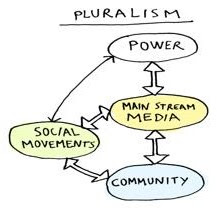In Wilson’s Theories of Governance, Pluralism is described as having “...so many governmental institutions in which power may be exercised-city, state, and federal governments and, within these, the offices of mayors, managers, legislators, governors, presidents, judges, bureaucrats-that no single group, even if it had many political resources, could dominate most, or even much, of the political process.” This is true to our government; we have many levels of government as mentioned in the quote, and we also have multiple branches of government that run our democracy: the executive, judicial, and legislative branch. Each of these groups takes a part in decision making, having to pass laws and policies through each other in order for them to go into effect. Our Democracy is split into groups through political parties as well. These parties, such as Republican and Democrat, represent and include large groups of people and their ideas. This shows Pluralism in our democracy because once again multiple groups are taking part in forming and controlling the government of our country. The reading also states that the groups within a Pluralistic government “...are responsive to their followers’ interests, and thus provide representation to almost all citizens affected by a policy.” This is similar to how senators and state representatives represent the American people, or their constituents. People can call into their representative’s office and give their say about the current political situation and how they want their representative to vote. It is then the representative’s choice whether to follow their own beliefs or vote for their constituents.
A modern example of pluralism in the United States would be the confederate statues debate. On one side of the debate there is a group of people who believe taking down the statues is “erasing history”. Some in that group (the white supremacists) even went as far as to start violent protests about the matter, which dominated national news for days. The other side of the debate wanted to remove the statues from public view, claiming they are very offensive to the African Americans who have to view them, and that they represent something America does not stand for. This debate influenced many government offices to either take down statues within their city or fight for them to stay. This shows how different groups within the United States influence the government and their actions. Some government officials took down statues feeling it was best for all groups involved, and others kept them up for the same reasoning.

No comments:
Post a Comment